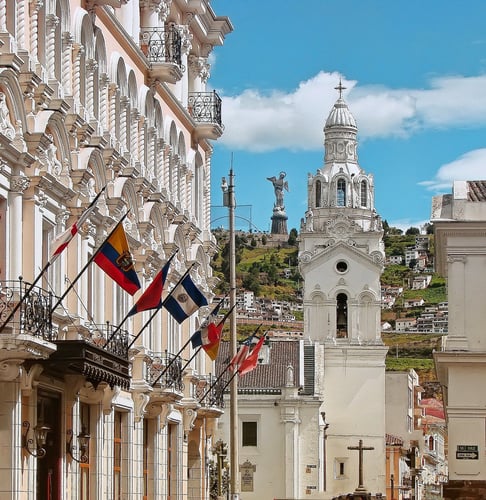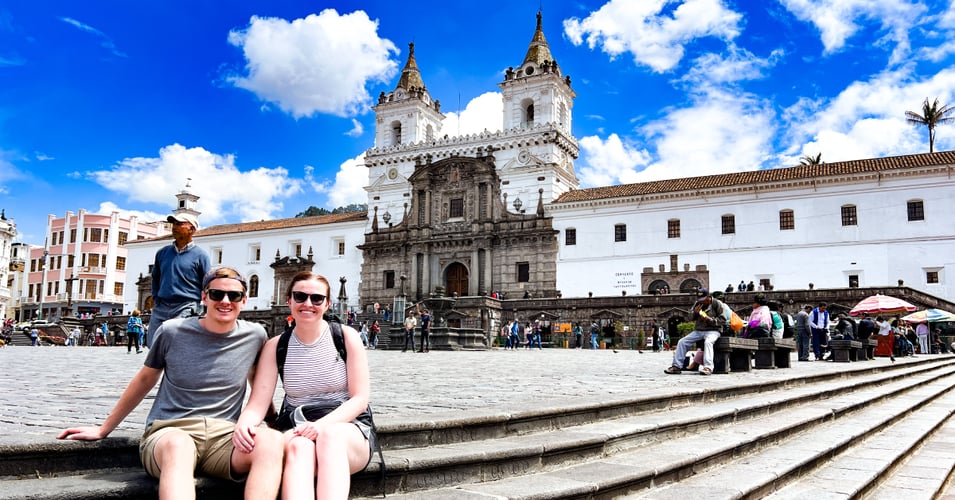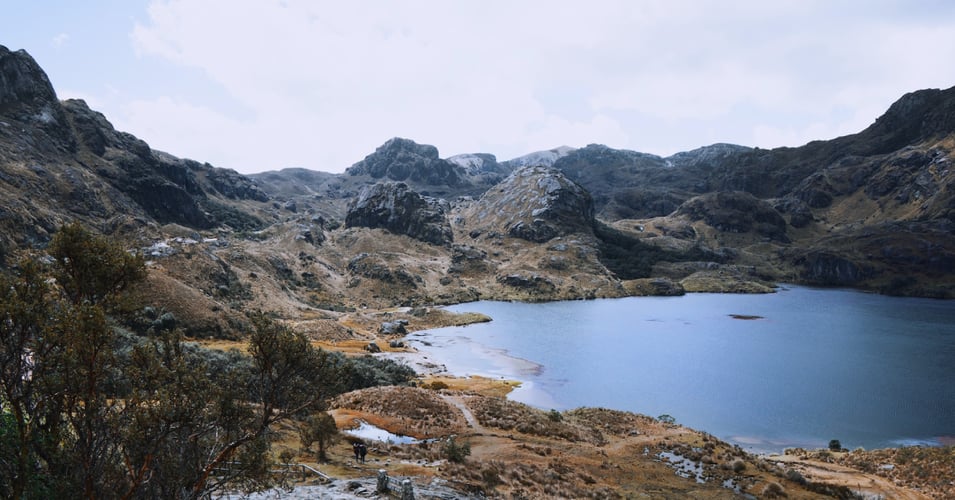Quito, a treasure in the middle of the Andes.
In the Ecuadorian capital, the roses are perfect, the melancholic music and the cuisine a tribute to traditions. Quito, a treasure in the middle of the Andes in South America, amazes with its famous historic center, full of churches, and surprises with one of the most vibrant creative scenes on the continent.
First World Heritage Site
Quito is the first city declared as Cultural Heritage of Humanity by UNESCO in 1978, and of course it has the historic center, which is considered the largest and best preserved in Latin America, the city is located in the middle of the Andes, thousand-year-old volcanoes, the old city takes us back to past times with its small streets and beautiful churches.
It can be noticed to this day, the deep of mixed race that exists there, an exquisite mix between indigenous, black and white natives, the skin of the people who inhabit these lands shows a wide range of colors; Due to all this «mestizaje» we find a unique and unrepeatable cultural value, full of traditions and customs, both ancient and modern. We can spend hours and hours walking through those small streets that transport us to the past, where we find true treasures of art and architecture.
Quito has the largest and best preserved historic center in Latin America, it has 40 churches, 16 monasteries and convents and around 4,000 heritage buildings of various styles.
The Largest and Best Preserved Historic Center in America
To get to know at least part of Quito, a treasure in the middle of the Andes, you have to take your time, because there are 17 squares, 40 churches, 16 convents and monasteries and around 4000 heritage buildings of the most varied styles, baroque, neoclassical, Neogothic, Mudejar (Arabic), in short, an amalgam as varied as its people. Without a doubt, the quintessential icon of Quito is the Convent and Church of San Francisco, the largest religious architectural complex in America, also called the Escorial of South America, the Franciscan convent has 13 cloisters, 2 chapels and the main church. , and keeps more than 3,500 works of art from the colonial era, where the well-known «Quiteña School of Arts» prevailed.
The Ecuadorian capital is settled between elevations:
- North.- Huanacauri (Temple of the Moon) San Juan
- South.- Yavirak (Temple of the Sun) El Panecillo
- East.- Itchimbia (Condor’s Nest)
- West.- Pichincha
Related Posts:
10 Museum you must visit in Quito

Basílica del Voto Nacional in Quito, Ecuador
Towards the north side of the old city is the neighborhood of San Juan, on a large «hill» or elevation, where the Basilica of the National Vow is located, the largest neo-Gothic temple in Ecuador, an immense religious structure built from the end of 19th century, it has been under construction for more than 100 years, and its construction has not been completed to this day; this church is the gateway to the historic center, from there begins García Moreno Street or Calle de las Siete Cruces.
WALK THROUGH THE OLD CITY
[padding right=»5%» left=»5%»]
The Plaza de la Independencia or Plaza Grande is the center of the city, and of course where the most important institutions with their respective buildings are located, on the west side is the Government Palace, on the south side the Primate Cathedral of Quito, on the This is the modern building of the capital’s Municipality and on the north side the Archbishop’s Palace, in the northwest corner of it we find the building of the old Magestic hotel, currently the Plaza Grande hotel, one of the most luxurious in the city. Quito is definitely a treasure in the middle of the Andes.
Walking through these picturesque streets, little by little you will arrive at «La Ronda» originally named Morales street, it is the bohemian street of Quito. At the beginning of the 20th century, this place was in its best splendor, it was the meeting point for writers, painters, musicians, and poets. Now you can enjoy live traditional Ecuadorian music, handicraft shops, traditional food restaurants, in this whole street they will offer you a delicious drink, the famous canelazo, which is an infusion of cinnamon, naranjilla or blackberry and could not miss the sugar cane liquor locally known as “puntas” or “puro” ideal to drink heat on the cold nights of Quito.
The city is located between mountains, to the north San Juan, to the east Itchimbia, to the west the Pichincha and to the south the Panecillo whose ancestral name is Yavirak (hill) or Shungoloma (hill of the heart) on its top is another of the icons of the city, the monument made with 7400 pieces of aluminum with 41 meters high «La Virgen de Quito» has been placed there since 1975, it is inspired by a well-known sculpture that is inside the church of San Francisco, made by Bernardo de Legarda in 1734, a sculpture of the immaculate virgin approximately 70 cm high.

Panecillo
On clear days, the best option to enjoy the panoramic view of the city and its surroundings is the Pichincha volcano, you can take the cable car from the base to the point known as Cruz Loma at 4100 meters above sea level and if you wish you can take a walk to the top of the mountain, without a doubt a wonderful experience.
MODERNITY IN THE CITY.
Leaving towards the north side of the Ecuadorian capital, we find fresh neighborhoods, far from the colonial era, which emerged at the beginning of the last century, in the midst of the republic, they have a lot of artistic and cultural movement. La Floresta is one of these modern neighborhoods, where filmmakers, artists, writers, painters coexist who have captured their best ideas on the walls of the neighborhood with beautiful murals and graffiti. If you want to enjoy an alternative film accompanied by a glass of the best wine, your option is the independent cinema «Ochoymedio»
Very close to there is La Mariscal, another modern and cool place, it is the heart of nightlife, the pink zone, where you can enjoy a night of fun and drinks with family and friends, there are bars, discos, clubs, lounges, restaurants, for all tastes and budgets. The epicenter of La Mariscal is Plaza Foch or Plaza de Quinde (hummingbird in Quichua) because there is a monument in the center of the square that alludes to this emblematic bird of the Andes.

It would be unforgivable to pass through Quito a treasure in the middle of the Andes without trying its exquisite gastronomy, nuanced by centuries of miscegenation, that is why we find the most varied dishes, with such varied ingredients, potatoes, corn in all its presentations, chicken meat, pork , cow sheep. If you like adventure, in addition to visiting the most expensive and gourmet restaurants, you can take a leap and stroll through several of the city’s markets, where you will find the flavor of the town, the purely traditional cuisine that has been transmitted from generation to generation. since centuries; You have to try the hornado, the guinea pig, the wide variety of ceviches, and although it sounds incredible, we recommend you – at least – ask for the «Caldo de Calavera» (skull broth/soup).
SOUVENIRS TO TAKE.
Here in Ecuador we call «recuerdos» to the famous souvenirs; of course the best souvenirs will be your experiences in this city, but why not take something to your friends or family? Something that reminds them of where you were and what you did there, in the city there are a huge number of craft shops, for all tastes and pockets; however, there is one place that stands out, where the artisans themselves sell their products, the craft market, located in the La Mariscal neighborhood, there you can find a little of everything, toquilla straw hats, hand-embroidered tapestries, clothing, handicrafts , chocolate, traditional liqueurs in the most creative packaging.
Undoubtedly an ancient city as modern, traditional as artistic, religious as liberal; a land full of contrasts and friendly people. When all this is over, come to the city, get to know its nooks and crannies, lose yourself in its art and transport yourself to the past living in the present.



